|
 Secure Site
Secure Site
|
 |
Archive for the 'Zen Timepiece by Now & Zen' Category
 wake up without an alarm clock Envision your wake-up time. As you lie in bed, think about the time at which you want to wake. Visualize a clock with that time on it, and visualize yourself getting up at that time. You may even find it helpful to tell yourself out loud, “I will wake up at (the desired time).” While this may sound silly, controlled experiments have revealed that many people can use these techniques to successfully and regularly awaken at the correct time without using an alarm or other external trigger. How the brain manages to keep track of the hours is unknown.
Or choose an Alarm Clock that doesn’t have a shrill, beeping sound like The Zen Alarm Clock by Now & Zen, Inc.
Our Zen Timepiece’s acoustic 6-inch brass bowl-gong clock is the world’s ultimate alarm clock, practice timer, and “mindfulness bell.”
It fills your environment with beautifully complex tones whenever it strikes. In the morning, its exquisite sounds summon your consciousness into awakening with a series of subtle gongs that provide an elegant beginning to your day. Once you experience the Zen Timepiece’s progressive awakening, you’ll never want to wake up any other way. It also serves as the perfect meditation timer. Available in 5 wood styles, including bamboo.
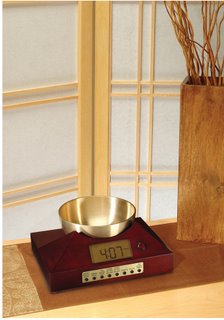 - bowl-gong alarm clock is an alternative to shrill alarm clocks
Now & Zen’s Bowl-Gong Alarm Clock Store
1638 Pearl Street
Boulder, CO 80302
(800) 779-6383
Posted in Bamboo Chime Clocks, Well-being, Zen Alarm Clock, Zen Timepiece by Now & Zen, Zen Timers
 Harunobu Suzuki, A girl Collecting Cchrysanthemum Dem by the Stream Culprit: The Blues
Research has indicated that people with depression may be four times more likely than the nondepressed to experience unexplained fatigue. Aerobic exercise—specifically, 30 minutes or more three to five days a week—is effective at treating mild to moderate depression, and may minimize the sleepiness associated with it. Set your Zen Timer for 30 minutes and try a few yoga poses in the comfort of your own home. If that doesn’t help, however, speak to your doctor, who may recommend talk therapy or a mood-boosting medication, like a selective serotonin re-uptake inhibitor (SSRI). If your depression and related fatigue seem to strike more frequently in winter, you could have seasonal affective disorder (SAD). Treatment for SAD may include using a special light box, says Marla Wald, a psychiatrist at Duke University Medical Center, in Durham, North Carolina. But venturing outside for about 20 minutes a day can provide similar benefits, she says.
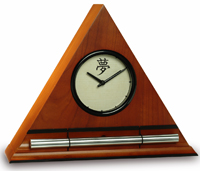 banish the blues by setting your zen timer Now & Zen Headquarter Store
1638 Pearl Street
Boulder, CO 80302
(800) 779-6383
Posted in Chime Alarm Clocks, mindfulness practice, Zen Alarm Clock, Zen Timepiece by Now & Zen
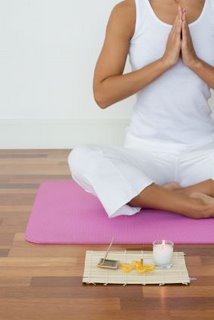 Take a Moment for Yourself When You Need a Moment…
Try a Sitting Meditation
To recenter your mind and body, sit on the floor in a comfortable position with a straight back. Set Your Zen Timepiece to repeat every 10 seconds. Inhale for ten seconds, then smoothly exhale for ten more. Repeat for at least three minutes and increase to 20 minutes as you improve.
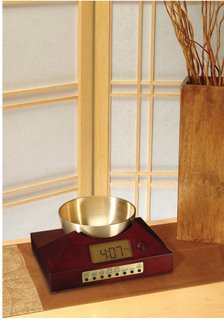 Set Your Singing Bowl Alarm to Repeat Every 10 Seconds
Posted in Bamboo Chime Clocks, Zen Timepiece by Now & Zen, Zen Timers
 progressive awakening Waking up in the morning is a metaphor for life — a kind of daily microcosmic reenactment of our overall purpose for being in the world. That is, just about every religious tradition emphasizes spiritual growth. And the connection between “awakening” and spiritual growth can be found in practically all forms of spiritual teaching.
So if waking up in the morning really is a metaphor for our larger spiritual lives, this perspective might help us treat our morning ritual of getting out of bed as a kind of spiritual practice. Indeed, when approached in this way, how we wake up in the morning can make a larger difference in our lives overall.
 waking up
Perhaps this is stretching the matter, but there are many people who do recognize that something as simple as waking up in the morning can be an authentic form of spiritual practice. For those who don’t have to go to work or get the kids to school, waking up naturally, whenever their body feels like it, can be a wonderful version of this practice. Waking up without an alarm, whenever your body has had enough rest, is probably the healthiest option, and the one that will leave us feeling most refreshed and ready to start the day.
However, there are few of us that have this luxury, especially during the week.
Fortunately, for those who want to wake up right, without being startled awake by an annoying alarm or some radio DJ, there is The Zen Alarm Clock. This clock was designed to make waking up a kind of spiritual practice.
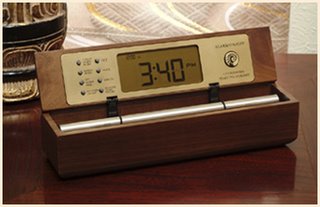 Digital Zen Alarm Clock
The Zen Clock wakes users with a built-in 10 minute gradual progression of acoustic chimes. And this gradual form of “progressive awakening” has been thoughtfully designed to include esoteric features that are fitting for a form of spiritual practice. For example, not only is the hardwood Zen Alarm Clock beautiful to see and hear, the clock’s chime is tuned to produce the same frequencies as the tuning forks used by musical therapists in their healing work. Moreover, the Zen Clock’s pre-programmed 10 minute chime progression sequence advances according to the “golden ratio,” which reflects both the natural proportions of our own bodies and the patterns of growth used in the overall evolution of the universe.
 love waking up with gentle chimes?
Even those who care little about such esoteric details nevertheless report that they love waking up with the gentle chimes of a Zen Alarm Clock. And as the makers of the Zen Alarm Clock hope, we may eventually come to see many of the simple details of our lives as forms of authentic spiritual practice.
Now & Zen Headquarter Store
1638 Pearl Street
Boulder, CO 80302
(800) 779-6383
Posted in Bamboo Chime Clocks, wake up alarm clock, Well-being, Zen Timepiece by Now & Zen
 why meditation works By MAIA SZALAVITZ
The image of the ancient but youthful-looking sage meditating on a mountaintop might be closer to reality than you think, according to a new study that found that after a three-month stay at a meditation retreat, people showed higher levels of an enzyme associated with longevity.
The study is preliminary and didn’t show that meditation actually extends life, but the findings suggest a possible means by which it could.
Researchers led by Tonya Jacobs of the University of California-Davis compared 30 participants at a meditation retreat held at the Shambhala Mountain Center in Colorado with matched controls on a waiting list for the retreat. Participants meditated six hours per day for three months. Their meditation centered on mindfulness — for instance, focusing solely on breathing, in the moment — and on lovingkindness and enhancing compassion towards others. (More on Time.com: Empathy Beats Bullies)
After the three-month intervention, researchers found that the meditators had on average about 30%* more activity of the enzyme telomerase than the controls did. Telomerase is responsible for repairing telomeres, the structures located on the ends chromosomes, which, like the plastic aglets at the tips of shoelaces, prevent the chromosome from unraveling. Each time a cell reproduces, its telomeres become shorter and less effective at protecting the chromosome — this, researchers believe, is a cause of aging. As the chromosome becomes more and more vulnerable, cell copying becomes sloppier and eventually stops when the telomeres disintegrate completely. Telomerase can mitigate — and possibly stop — cell aging.
“Something about being on a retreat for three months changed the [amount of] telomerase in the retreat group,” says Elizabeth Blackburn, a study author who has won a Nobel Prize for her previous work on telomerase. “We didn’t prove that it was meditation [that caused the change]. A lot of things happened during the retreat. But the interesting thing was that the changes we saw tracked quantifiably with the change in people’s psychological well-being and outlook.”
 meditating on a rock In other words, people with higher levels of telomerase also showed more increases in psychological improvement. In retreat participants who showed no psychological change, telomerase levels were not any higher than in controls. (Researchers were unable to compare telomerase levels in the groups both before and after the retreat for logistical reasons.)
“It’s a very good study with interesting results in terms of health implications,” says Alan Marlatt, a professor of psychology at the University of Washington who has studied meditation for decades but was not associated with this research.
Of course, the relationship between health and telomerase is complex. In a recent study in mice by Harvard researchers, they found that boosting levels of telomerase reversed signs of aging, restoring graying fur and fertility, increasing brain size and sharpening scent perception. Too much telomerase activity can also be a problem, however. A cell that reproduces endlessly sounds like a good thing at first — that cell would be immortal. But this is exactly what happens with cancer cells — infinite replication. “If telomerase levels go too far up, that’s [associated with] cancer,” says Clifford Saron, associate research scientist at the University of California-Davis Center for Mind and Brain and a co-author of the new paper. He notes, however, that the difference is one that is orders of magnitude higher—so that meditation could not possibly cause cancer*.
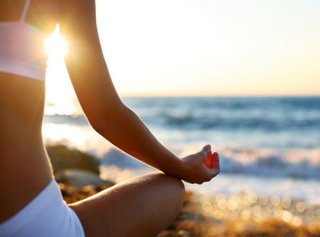 Woman meditating on the beach at sunset So how does meditation affect the machinery of cellular reproduction? Probably by reducing stress, research suggests. Severe psychological stress — particularly early in life and in the absence of social support — has been linked with poorer health, increasing risk for heart disease, stroke and some cancers. This is likely due to the negative effects of high levels of stress hormones on the brain and body. By reducing stress hormones, perhaps meditation contributes to healthier telomeres.
In a study published a few years ago in Lancet Oncology, researchers compared 30 men before and after adopting lifestyle changes following a diagnosis of low-risk prostate cancer. The patients started meditating, switched to a healthy plant-based diet, exercised and attended a support group. Like the new study, the Lancet Oncologypaper found increases in telomerase linked with reduced psychological distress.
“The mind has a big influence on the body. If you get anxious, your heart beats faster and your stomach churns,” says Blackburn. “But we don’t know yet [if meditation is linked to] a reduction in stress hormones. The physiology is very complex.”
Recent evidence supports a connection: a study published this month in the Archives of General Psychiatry showed that mindfulness meditation can reduce relapse in patients who recovered from depression just as well as antidepressants.
Of course, the increases in telomerase seen in the current study could be due to some other unknown factor that separates the meditators from the controls. That’s another reason why it’s too early to suggest that stress-reducing mind-body interventions like meditation be prescribed as a treatment for any diseases or disorders. The study also did not show that meditation actually extends life, only that it may increase the activity of an enzyme that is associated with longevity.
Still, research on meditation is expanding dramatically, with studies finding it helpful for pain, depression, addiction and many other conditions. “There’s a very exciting dialogue going on,” Marlatt says of the research. “It works for many different kinds of clinical problems. It’s very promising.”
That noise you hear in the background? Millions of new meditators chanting, “Om.”
adapted from Time Magazine, Dec. 2010
Use our unique “Zen Clock” which functions as a Yoga Timer. It features a long-resonating acoustic chime that brings your meditation or yoga session to a gradual close, preserving the environment of stillness while also acting as an effective time signal. Our Yoga Timer & Clock can be programmed to chime at the end of the meditation or yoga session or periodically throughout the session as a kind of sonic yantra. The beauty and functionality of the Zen Clock/Timer makes it a meditation tool that can actually help you “make time” for meditation in your life. Bring yourself back to balance.
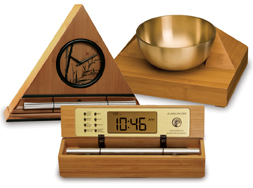 meditation timers with singing bowl chime Now & Zen’s Meditation Timer Store
1638 Pearl Street
Boulder, CO 80302
(800) 779-6383
Posted in Bamboo Chime Clocks, Chime Alarm Clocks, Now & Zen Alarm Clocks, Zen Timepiece by Now & Zen
 Meditation - Utamaro Woman I have always been intrigued by the idea of meditation. I would love to be able to sit quietly, relax and let my mind wander into a trancelike rest, all at the same time.
There are reported medical benefits to regular meditation too: you can bring down your heart rate and blood pressure. Meditation has been shown to help insomniacs sleep, nervous Nellies relax and those withchronic pain breathe more easily.
Meditation sounds like a perfect dream, actually, but who has time for that? As a television producer, I would say my daily list of things to do can run longer than a pilgrimage to the Ganges. Would it be worth adding meditation to my to-do list? I needed to be convinced.
So I went to Avery Fisher Hall in Manhattan for a group meditation led by Sri Sri Ravi Shankar, a spiritual leader and founder of The Art of Living Foundation. “The Guru,” as he is called, traveled from southern India to kick off the “I Meditate NY” campaign, designed to introduce stressed-out New Yorkers to the powers of the ancient practice of meditation. Gathered in the hall normally reserved for plays and operas were nearly 2,700 people ready to follow the spiritual teachings of the master on stage.
The preparation began with ancient Sanskrit chants from the folk group Bakti and soulful vocals from the Grammy-nominated singer Chandrika Tandon. But before long The Guru took center stage, sitting in the lotus position on a regal loveseat.
With a creeping smile on his face, he began to explain the three platinum rules of meditation. The first, he said, was to say to oneself, “For the next 10 minutes, I want nothing.” Sounded simple enough, but the truth is I did want something. I was a little hungry, even though I had a pretty big cheeseburger a few hours earlier. It even had all sorts of extras on it. My mind started to wander: Why was I hungry when I just had a big meal? Maybe it wasn’t as big as I thought? Oh man, that means that cheeseburger must have clearly been full of empty calories.
But The Guru had already moved on to platinum rule number two: “For the next 10 minutes, I do nothing.” Just then, my foot started to itch. I reached down to scratch it immediately, figuring the clock hadn’t yet started.
Rule three: “For the next ten minutes, I am nothing.” Now he was on to something. I liked that idea. It made me feel as if I had permission to float away, let my spirit drift into oblivion, all the while surrounded by thousands of people.
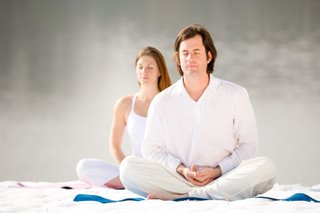 Meditation - Choose a Gong Meditation Timer Sounds of Silence
The group was full of Om’s and ready to sink into silence… or so we thought. Just then, The Guru reached into the pocket of his caftan for hiscellphone. The crowd burst into laughter — no doubt, this was a 21st-century guru. He promised it was only to time our imminent meditation, which he has said would last about 10 minutes.
Now we were on our way. He asked everyone to keep still and be quiet. If you didn’t think you could do so, it was now time for you to leave. He said nobody should leave in the middle of the journey, as that would not be fair to others around them. Parents with children were asked to leave now. It was time to begin.
The room fell silent, but not silent enough. There were coughs, bodily noises, feet sliding, and yes, a cell phone. I thought, it’s going to be tough to concentrate on doing nothing. The coughs seemed ceaseless. I wondered, well, we are heading into allergy season, is that why there are so many coughs? Or is this just how people always are? It isn’t often I’m in a room with 2,700 people.
But then something happened. I don’t really know what happened, because it’s as if I wasn’t there when it occurred. I mean, I was there, but I was nothing more than just there. Sitting. Breathing. Not hearing coughs. Not hearing feet shuffling. Not even hearing silence. I was awake. I was conscious. It wasn’t that hard. I was peaceful. I was meditating.
There we were. An auditorium full of silent people, together, effortless, releasing our minds from daily stress, buried in peace, meditating.
Meditation: Struggling to Do Nothing
And then it was over. The Guru woke us up — and then he gave us a jolt. He told us in his gentle meandering voice that we had been in this “amusement paradise” for 22 minutes. Not 10 minutes as he had suggested, but more than double that. The entire room gasped. We had disappeared for nearly the length of an evening news broadcast.
And, even though it felt counterintuitive to do something so seemingly solitary with so many others, it actually now made perfect sense. Later, The Guru told me, “Group meditations help in creating a positive energy in the atmosphere.” Meditation was all about vibrations, he said. Just as we “catch anger” from angry people around us, we “catch” positive energy from positive people around us. The room was surely full of positivity.
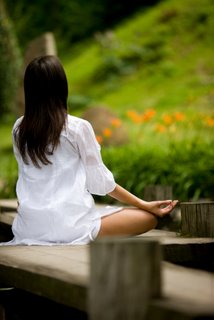 meditation timers with gongs So there you have it. A frazzled New Yorker with a Ganges-long list of to-dos may have just peacefully and willingly made her list longer.
Use our unique “Zen Clock” which functions as a Yoga & Meditation Timer. It features a long-resonating acoustic chime that brings your meditation or yoga session to a gradual close, preserving the environment of stillness while also acting as an effective time signal. Our Yoga Timer & Clock can be programmed to chime at the end of the meditation or yoga session or periodically throughout the session as a kind of sonic yantra. The beauty and functionality of the Zen Clock/Timer makes it a meditation tool that can actually help you “make time” for meditation in your life. Bring yourself back to balance.
It’s exquisite sounds summon your consciousness out of your meditative state with a series of subtle gongs. Once you experience the Zen Timepiece’s progressive tones, you’ll never want to meditate any other way. It serves as the perfect meditation timer. Available in 5 wood styles, including bamboo.
adapted from WorldNewsReport.com by Gitka Ahuja
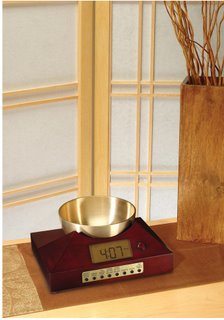 Gong Meditation Timers for Your Stillness Practice Now & Zen – The Gong Meditation Timer Store
1638 Pearl Street
Boulder, CO 80302
(800) 779-6383
Posted in Well-being, Yoga Timer, Yoga Timers by Now & Zen, Zen Alarm Clock, Zen Timepiece by Now & Zen, Zen Timers
 It's okay to nap during the day - Choose a gentle wake up - a Chime Zen Alarm Clock Have you ever felt an overpowering urge to find privacy and a bed for a midday “quickie?” Don’t feel guilty about that. It’s just your body telling you what it needs — sleep!
It’s unfortunate that most daily schedules can’t accommodate that need. Quickie naps are good for you. During the nap period of seeming inactivity, you do not simply “turn off;” complex reparative processes occur in your body. While the exact physiologic mechanisms responsible for the benefits of napping are not yet well understood, its positive outcomes have been confirmed in studies: they include improvements in mood, alertness, memory, performance and decision-making ability.
Let’s start with the best time for a nap: afternoon. An afternoon nap does not disrupt normal circadian (meaning: about a day) rhythms, whereas a morning or evening nap can — making it harder for you to return to your usual sleep routine that night. Your body probably already tells you this: circadian changes in your hormones and temperature are likely to make afternoon a naturally sleepy time for you. These cyclical patterns help explain why simply tacking more minutes or hours of sleep onto your nocturnal sleep time won’t necessarily prevent afternoon sleepiness. No matter how much you sleep at night, the afternoon urge will probably hit you.
How long should you nap? About 20 minutes. Anything much longer can backfire. You know that prolonged groggy feeling you sometimes feel after a nap? It’s called sleep inertia; you may have experienced it if you napped too long. Sleep inertia can take anywhere from 15 minutes to 4 hours to wear off. During this period, studies have shown impairments in mood, alertness, memory, performance and decision-making abilities. The likelihood of developing sleep inertia depends on several factors, one of which is the sleep stage from which you awaken. In a June, 2006 study in Sleep (the peer-reviewed publication of the Associated Professional Sleep Societies), investigators demonstrated the positive cognitive effects following 10- and 20-minute naps, but also the negative effects of sleep inertia following a 30-minute nap. The 30-minute timing coincides with the normal onset of deep sleep (also called slow-wave sleep). Limiting your nap time will help prevent entry into deep-sleep stages — avoiding sleep inertia while minimizing disruptions to your normal nocturnal sleep.
 Choose the most natural wake up -- a gentle Zen Alarm Clock with Soothing Chimes Keep in mind quickie-napping can’t compensate for significant sleep debt. While the increasing demands of our lifestyles may not reflect it, a wealth of research has verified that most adults require an average of 7 to 9 hours of sleep each night. Be mindful of persistent sleepiness throughout the day, despite adequate nocturnal sleep: it may be a symptom of a sleep disorder (such as narcolepsy, periodic limb movements, or obstructive sleep apnea) or an underlying medical problem (such as thyroid disease, serious infection or illness, anxiety or depression). Always listen to your body and speak with your doctor about your concerns.
And … try to sneak in a midday nap. But, remember, keep it quick!
Dr. Nayer Khazeni specializes in internal medicine and pulmonary/critical care, teaches, and conducts research at Stanford University Medical Center.
Waking up in the morning should be as pleasant as falling asleep at night. The Zen Alarm Clock’s gradual, gentle awakening is transformative.
Our Zen Timepiece’s acoustic 6-inch brass bowl-gong clock is the world’s ultimate alarm clock, practice timer, and “mindfulness bell.”
It fills your environment with beautifully complex tones whenever it strikes. In the morning, its exquisite sounds summon your consciousness into awakening with a series of subtle gongs that provide an elegant beginning to your day. Once you experience the Zen Timepiece’s progressive awakening, you’ll never want to wake up any other way. It also serves as the perfect meditation timer. Available in 5 wood styles, including bamboo.
adapted from sfgate.com by Nayer Khazeni, M.D.
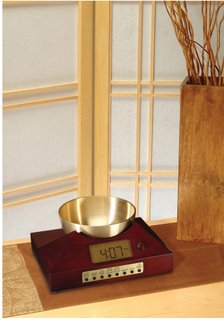 The Zen Timepiece - An acoustic 6-inch brass bowl-gong clock Now & Zen – The Bowl Gong Clock Store
1638 Pearl Street
Boulder, CO 80302
(800) 779-6383
orders@now-zen.com
Posted in sleep, Sleep Habits, wake up alarm clock, Zen Alarm Clock, Zen Timepiece by Now & Zen, Zen Timers
 Meditation as a Transformation Tool - Ukiyo-e Many moons ago, a wandering Nepalese prince sat under a tree, vowing not to rise until he attained enlightenment.
After a long night of deep meditation, Siddhartha Gautama, better known as the Buddha, saw the light and declared that suffering is subjective, and can be reduced through self-awareness.
Today, 2500 years later, a growing number of American doctors and healthcare workers are teaching people who are ill how to apply Buddha’s epiphany to their lives.
adapted from abcnews.com by By Ephrat Livni
In hospitals, businesses and community centers around the country, meditation is increasingly being offered as a method of stress reduction, and to help patients better cope with the physical pain and mental strain associated with many medical conditions, including heart disease and HIV infection.
Recent research shows meditation’s soothing effects can be detected in arterial walls and in the brain. Once considered outside the mainstream, today more insurers are paying for meditation, both as a form of medication and as preventive medicine.
Learning to ‘Disidentify’
“Meditation is the act of disidentifying from inner thought flow and concentrating on calming and healing,” explains Robert Thurman, Ph.D., a professor of Indo-Tibetan Buddhist Studies at Columbia University in New York and the first American to become a Tibetan Buddhist monk. Through meditation, doctors help patients detach from their pain and anxieties and cultivate a connection between the mind and the body, he says.
 Gong Clock - Progressive, Soothing Tones to End Your Stillness Practice While there are many kinds of meditation, the mindfulness approach, used widely in hospitals around the country, focuses primarily on breathing. Practices vary, but the basic idea involves sitting comfortably, with eyes closed, spine straight and attention focused on breathing.
Practitioners aim to maintain a detached, calm awareness of their thoughts and sensations. Through mindfulness, experts say, meditators learn to pay attention to the present and cultivate clarity of mind, equanimity and wisdom.
Minor Mindfulness Miracles
All of which may sound very abstract. Unless, points out Jeff Brantley, Ph.D, Director of the Mindfulness-based Stress Reduction (MBSR) Program at the Duke Center for Integrative Medicine in Durham, N.C., you are a patient who is suffering.
“We had one patient, a 40-year-old woman with metastatic breast cancer who was enrolled in the 8-week MBSR program. At her exit interview she said that before the course began 5 minutes wouldn’t go by without her worrying about what would become of her and her young family and now, after the class, she can concentrate on other things for more than hour at a time, even days,” Brantley says, calling the results “a minor miracle.”
The Duke program is one of at least 70 such mind-body based courses modeled on the University of Massachusetts Medical School’s Stress Reduction Clinic, in Worcester, Mass., created in 1979 by Dr. Jon Kabat-Zinn. Taught mainly in hospitals around the country, mindfulness training is typically run as an 8-week-long outpatient program to complement other medical treatments.
The aim, according to a website dedicated to Mindfulness-based Stress Reduction, is to assist people in taking better care of themselves “through a gentle but rigorous daily discipline of meditation and relaxation.”
Doctors refer patients to mindfulness programs for any number of diseases and disorders, including heart disease, anxiety and panic, job or family stress, chronic pain, cancer, HIV infection, AIDS, headaches, sleep disturbances, type A behavior, high blood pressure, fatigue and skin disorders.
In keeping with the growing interest in preventative medicine, some insurance companies, such as Blue Cross/Blue Shield in Massachusetts and a number of insurers in what Thurman calls “the more enlightened states like Oregon and California,” are now paying for all or part of these programs.
Research for Coverage
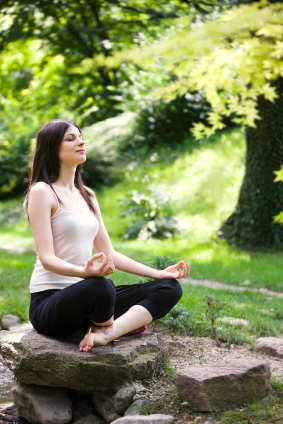 Meditation for Well-being, Choose a Soothing, Chime Timer While the National Institutes of Health says it is too soon to quantify the medical benefits of meditation, Anita Greene, spokeswoman for the Institute’s Complementary and Alternative Medicine division, concedes, “It is a therapy worthy of further scientific investigation to refute or support the health claims being made.”
In fact, in 1999, the NIH granted Maharishi University of Management in Fairfield, Iowa, $8 million during a five-year period to study the effects of meditation in African Americans with cardiovascular diseases.
Researchers at Maharishi say that relaxing and reducing stress through transcendental meditation may reduce artery blockage and the risk of heart attack and stroke, according to a study released in the March issue of the American Heart Association’s journal Stroke (see related story).
Another recent pilot study, published in the May 15 issue of NeuroReport, by Sara Lazar, Ph.D., a Harvard research fellow in psychology at Massachusetts General Hospital, in Boston, suggests meditation activates specific regions of the brain that may influence heart and breathing rates. Using a brain imaging technique known as functional magnetic resonance imaging, or fMRI, Lazar measured blood flow changes in experienced meditators.
“What we found were striking changes. There was significant decrease in blood flow and activity in specific areas of the brain,” says the study’s senior author Dr. Herbert Benson, president of the Mind/Body Medical Institute at Beth Israel Deaconess Medical Center in Boston, Mass.
The usual, fight-or-flight brain response liberates adrenalin and is stressful to the body, he explains, but during meditation the brain acts to quiet the body through concentrated breathing or word repetition, evoking a relaxation response that minimizes the harmful effects of stress.
“It does away with the whole separation of mind and body and gives further proof to insurers that [meditation] is cost effective,” he says. Ultimately, Benson predicts, medicine will be akin to a three-legged stool, leaning on pharmaceuticals, surgeries and procedures, and self-care, which includes, meditation, nutrition, exercise and health management.
A Tool for Transformation
But, Thurman points out, meditation is for more than just health benefits: It is a tool for seeking inner transformation. Meditation practices in the health field are secular, however.
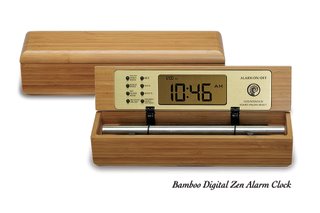 Gong Clock for Meditation and Yoga Practices “We get everyone from born-again Christians to avowed atheists. We tell people we are not trying to make anyone into anything,” Duke’s Brantley reassures. No matter what their religious persuasion, he says, patients find an increased awareness and appreciation of their lives.
Registered nurse Shirley Gilloti, a San Rafael, Calif., health educator and mindfulness training teacher agrees, “I tell people to try to bring more mindfulness to saying their rosary if that’s what they do.”
Use our unique “Zen Clock” which functions as a Yoga & Meditation Timer. It features a long-resonating acoustic chime that brings your meditation or yoga session to a gradual close, preserving the environment of stillness while also acting as an effective time signal. Our Yoga Timer & Clock can be programmed to chime at the end of the meditation or yoga session or periodically throughout the session as a kind of sonic yantra. The beauty and functionality of the Zen Clock/Timer makes it a meditation tool that can actually help you “make time” for meditation in your life. Bring yourself back to balance.
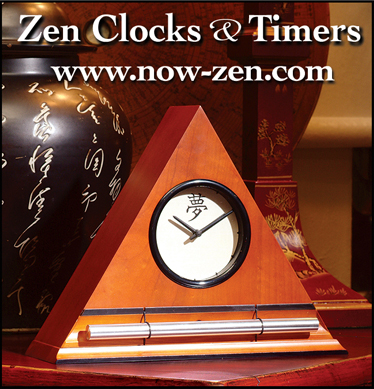 Gong Clock & Timers by Now & Zen, Inc. - Boulder, CO Now & Zen – The Gong Clock Shop
Downtown Boulder, CO
1638 Pearl Street
Boulder, CO 80302
(800) 779-6383
Orders@Now-Zen.com
Posted in Bamboo Chime Clocks, Yoga Timer, Yoga Timers by Now & Zen, Zen Alarm Clock, Zen Timepiece by Now & Zen
 Cherry Blossoms
Beyond the psychological inquiry into dreams or the self-improvement techniques of affirmations lies the ancient and sacred practice of meditation. Some form of meditation is practiced in every major world religion. Yogis, Christian mystics, Zen Buddhists, Quakers, practitioners of the Kabbalah, and Secular Humanists, all experience the benefits of meditation.
 A Moment of Stillness in Nature
The Zen Timepiece is an exquisite “accoutrement to meditation.” It can be used in a variety of ways to aid your practice and encourage you to “make time” to meditate. The first and most basic use of the Zen Timepiece in your meditation practice is as a signal of the end of your allotted meditation time.
If you want to meditate for twenty minutes, simply set our Chime countdown timer for twenty minutes and begin your meditation. When the countdown timer reaches zero and the bowl/gong is struck, you can choose to end there or continue your meditation for about three and a half minutes until the next bowl strike, or even longer. Many meditators find that a “three and a half minute warning” is a perfect interval in which to gradually conclude their longer meditations. The first strike signals the final phase of the meditation and the second strike its conclusion. The beauty of the brass bowl/gong is that it complements rather than disturbs the meditative state while acting as an effective timer. No matter how you use it, the sonic clarity of the brass bowl provides an appropriate conclusion to your stillness.
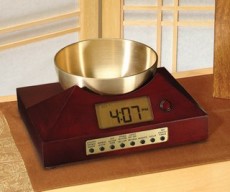 Now & Zen Headquarter Store, Boulder, CO
Now & Zen Headquarter Store, Boulder, CO
The bowl that comes with the Zen Timepiece is made from the following five metals: copper, zinc, lead, iron, and tin. It has been formed using the same forging techniques that have been used in Asia for two thousand years. Unlike hand-hammered Himalayan-style bowls, our Zen Timepiece’s rin gong bowl is made using methods which first appeared in Japan in the first century. Following these traditions, your bowl’s long-resonating tone has been carefully selected to bring beauty and harmony to your environment.
 Clocks and Timers with Gentle, Soothing Chimes
Now & Zen’s Chime Alarm Clock Shop
Home of The Zen Alarm Clock & Zen Timepiece with Singing Bowl
1638 Pearl Street
Boulder, CO 80302
(800) 779-6383
Posted in Japanese Inspired Zen Clocks, Meditation Timers, Meditation Tools, Natural Awakening, Now & Zen Alarm Clocks, Progressive Awakening, Yoga Timers by Now & Zen, Zen Timepiece by Now & Zen, Zen Timers
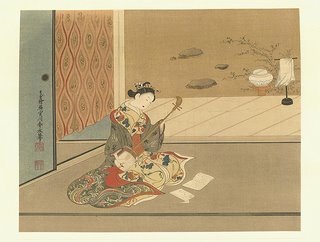 Set Your Gong Meditation Timer - Dama tocando el Samisem -artista Shunsui Katsu-Miyagawa A certain type of meditation may help the brain retain images for short periods, says a new study on visual-spatial abilities.
When people view an object, they usually retain a clear picture of it in their visual short-term memory for only a few seconds before the details fade. An experiment by George Mason University researchers, though, found that people who practice Deity Yoga (DY) do much better at visual-spatial tasks shortly after they meditate.
The study’s authors, writing in a recent issue of Psychological Science, said the finding may have “many implications for therapy, treatment of memory loss and mental training.”
Practitioners of DY meditation zero in on an image of their deity, conjuring up a vivid, three-dimensional mental picture of it while honing in on the deity’s emotions and environment.
In the experiment, led by psychologist Maria Kozhevnikov, meditation and non-meditation practitioners performed two visual-spatial tests: imagining the rotation of a 3-D object and viewing an image, then trying to identify it from among several other similar images. After a first round of tests, the participants spent the next 20 minutes either meditating or performing non-meditative tasks before being tested again.
All the subjects had similar scores on the first round of tests, suggesting that meditating in general causes no overall, long-term improvement in visual-spatial skills.
However, those who performed DY meditation between rounds did much better on both tasks in the second phase of tests than those who did non-meditative activities or practiced Open Presence (OP) meditation. OP practitioners, rather than focusing on a specific thing, try to achieve awareness by contemplating a wider array of experiences, images or thoughts that may come to them.
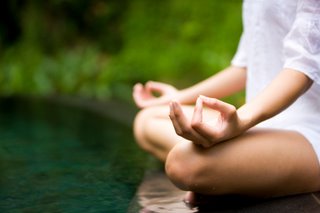 Choose a Gong Meditation Timer for Your Mindfulness Practice The study authors concluded that further investigations should be done to see if other visual meditation techniques can produce similar improvements in visual-spatial memory or if the results are specific to DY meditation.
Use our unique “Zen Clock” which functions as a Yoga & Meditation Timer. It features a long-resonating acoustic chime that brings your meditation or yoga session to a gradual close, preserving the environment of stillness while also acting as an effective time signal.
Our Yoga Timer & Clock can be programmed to chime at the end of the meditation or yoga session or periodically throughout the session as a kind of sonic yantra. The beauty and functionality of the Zen Clock/Timer makes it a meditation tool that can actually help you “make time” for meditation in your life. Bring yourself back to balance.
More information
The National Center for Complementary and Alternative Medicine has more about the health benefits of meditation.
SOURCE: Association for Psychological Science, news release, April 27, 2009
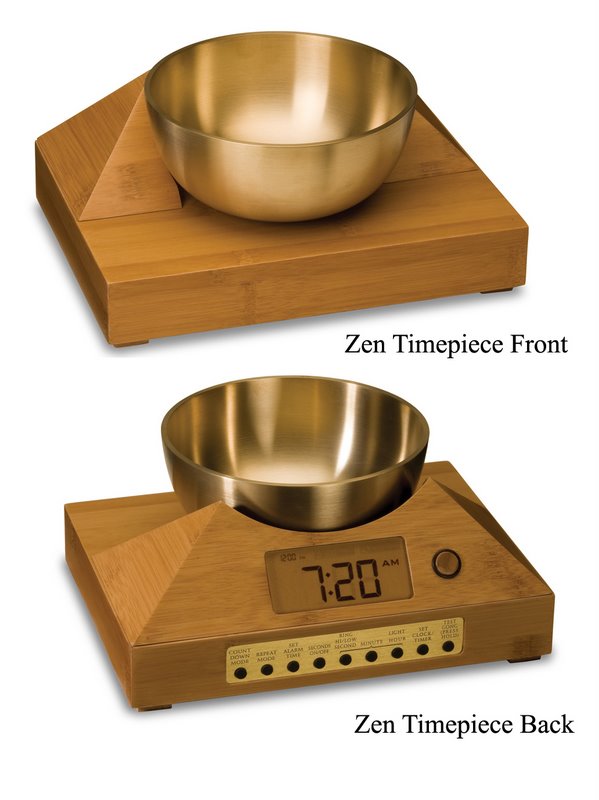 Set Your Gong Meditation Timer for Your Mindfulness Practice Now & Zen – The Gong Meditation Timer
 The Gong Meditation Store - Boulder, CO 1638 Pearl Street
Boulder, CO 80302
(800) 779-6383
orders@now-zen.com
Posted in Well-being, Yoga Timers by Now & Zen, Zen Timepiece by Now & Zen, Zen Timers
« Previous Page — « Previous Entries
Next Entries » — Next Page »
|
|
|
|